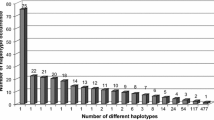Summary
We have confirmed the autosomal, co-dominant mode of inheritance for the three common phenotypes for the C3 system proposed by other authors. This was done through the study of 31 twin pairs (15 monozygotic and 16 dizygotic), 24 families with 43 children and finally 34 mother-child pairs. The formal genetic model is a two allele (C3S and C3F) three phenotypes (S, SF, F) one, which is also in accord with the findings of other authors. There were no differences in the distribution of C3 phenotypes between the sexes basing on a study of 96 women and 114 men from the German population. These observations indicated the usefulness of applying this system in cases of disputed paternity. The theoretical probability of exclusion of a man falsely accused, based on this system is 13.14%. This probability is based on the gene frequencies of C3S = 0.8071 and C3F = 0.1928. Examination of 27 cases of disputed paternity enabled us to exclude one of the accused men in 2 cases based only on this system. Thus the empirical rate of exclusion is 7.40%. Possible reasons for the discrepancy are discussed.
Zusammenfassung
Zur Feststellung der Vererblichkeit und des Vererbungsmodus des C3-Proteins haben wir Phänotypenbestimmungen bei insgesamt 31 Zwillingspaaren (16 zwei-eiigen und 15 eineiigen), 24 Familien mit 43 Kindern und schließlich 34 Mutter-Kind-Paaren vorgenommen. Dabei haben wir eine autosomale, kodominante Vererbung dieser Serum-protein-Phä notypen feststellen können, was auch mit den Ergebnissen anderer Autoren über-einstimmt. Damit kann das vorliegende formalgenetische Modell als zutreffend gelten: drei Phänotypen (C3 S, SF, F) gesteuert von zwei autosomal kodominanten allelen Genen (C3S und C3F). Dies stimmt vollkommen überein mit den von anderen Autoren vorgenommenen Untersuchungen. Geschlechtsunterschiede in der C3-Phänotypenverteilung liegen nicht vor, da unsere Untersuchung an einer deutschen Stichprobe (96 Frauen und 114 Männer) keine signifikanten Unterschiede zeigte. Auch dies stimmte mit den bisherigen Ergebnissen anderer Autoren überein. Darüber hinaus haben wir die Anwendbarkeit und Aussagekraft dieses Systems bei Vaterschaftsnachweisen auf Grund der Auswertung der von uns errech-neten Genfrequenzen in Rheinland-Pfalz (C3S = 0,8071, C3F = 0,1928) überprüft, wobei wir ein relativ gutes Ergebnis erzielten, indem die theoretische Ausschlußwahrscheinlichkeit für das C3-System 13,14% beträgt. Durch Untersuchung von 27 Vaterschaftsgutachtenfällen konnte in 2 Fällen jeweils ein Mann allein auf Grund dieses Systems durch einen klassischen Ausschluß als Vater ausgeschlossen werden. Dies ergibt eine empirische Ausschlußquote von 7,40%. Der Grund dieser Diskrepanz zwischen theoretischer und empirischer Ausschlußchance wird nachstehend erörtert.
Similar content being viewed by others
Literatur
Alper, C. A., Propp, R. P.: Genetic polymorphism of the third component of human complement (C3). J. clin. Invest.47, 2181–2191 (1968).
Azen, E. A., Smithies, O.: Genetic polymorphism of C3 (β1c-globulin) in human serum. Science162, 905–907 (1968).
Azen, E. A., Smithies, O., Hiller, O.: High-voltage starch-gel-electrophoresis in the study of post-albumin proteins and C3 (β-1cglobulin) polymorphism. Biochem. Genet.3, 215–228 (1969).
Dissing, J., Sørensen, H.: Studies on C3 polymorphism in Denmark. Hum. Hered.21, 272–277 (1971).
Farhud, D. D., Walter, H.: Polymorphism of C3 in German, Bulgarian, Iranian and Angola population. Humangenetik16, 161–164 (1972).
Goedde, H. W., Benkmann, H. G., Hirth, L.: Genetic polymorphism of C3 (β1c-globulin) component of complement in a German and Spanish population. Humangenetik10, 231–234 (1970).
Hummel, K.: Die medizinische Vaterschaftsbegutachtung mit biostatistischem Beweis. Stuttgart: Fischer 1961.
Hummel, K.: Ergänzende lg Y/X-Tabellen zur Berechnung der Vaterschaftswahrscheinlichkeit im serologischen Gutachten. Z. Immun.-Allergieforsch.125, 277–284 (1963).
Hummel, K.: Biostatistische Abstammungsbegutachtung mit Blutgruppenbefunden. Stuttgart: Fischer 1971.
Krüger, J., Fuhrmann, W., Lichte, K.-H., Steffens, Chr.: Zur Verwendung des Polymorphismus der sauren Erythrozytenphosphatase bei der Vaterschaftsbegutachtung. Dtsch. Z. ges. gerichtl. Med.64, 126–146 (1968).
Mayer, M. M.: Nomenclature and reaction mechanism of the complement system. Amsterdam: Elsevier Publishing Company 1967.
Prokop, O.: Die menschlichen Blut- und Serumgruppen. Stuttgart: Fischer 1971.
Rittner, Ch. (Ed.): First International Symposium and Workshop on the Polymorphism of the Third Component of the Human Complement System. Vox. Sang.34 (1973, in the press).
Teisberg, P.: High voltage agarose gel electrophoresis in the study of C3-polymorphism. Vox Sang. (Basel)19, 47–56 (1970).
Teisberg, P.: The distribution of C3-types in Norway. Hum. Hered.21, 154–161 (1971a).
Teisberg, P.: Genetics of the C3-system. Hum. Hered.21, 458–466 (1971b).
Wieme, R. J., Demeulenaere, L.: Genetically determined electrophoretic variant of the human complement component C3. Nature (Lond.)214, 1042 (1967).
Author information
Authors and Affiliations
Additional information
Diese Publikation ist ein Teil der Dissertationsarbeit, die im Juni 1972 an die Naturwissenschaftliche Fakultät der Universität Mainz eingereicht worden ist.
Rights and permissions
About this article
Cite this article
Farhud, D.D., Walter, H. Verwendung des C3(β1c-Globulin)-Polymorphismus bei der Vaterschaftsbegutachtung. Z Rechtsmed 72, 225–232 (1973). https://doi.org/10.1007/BF02079410
Received:
Issue Date:
DOI: https://doi.org/10.1007/BF02079410



